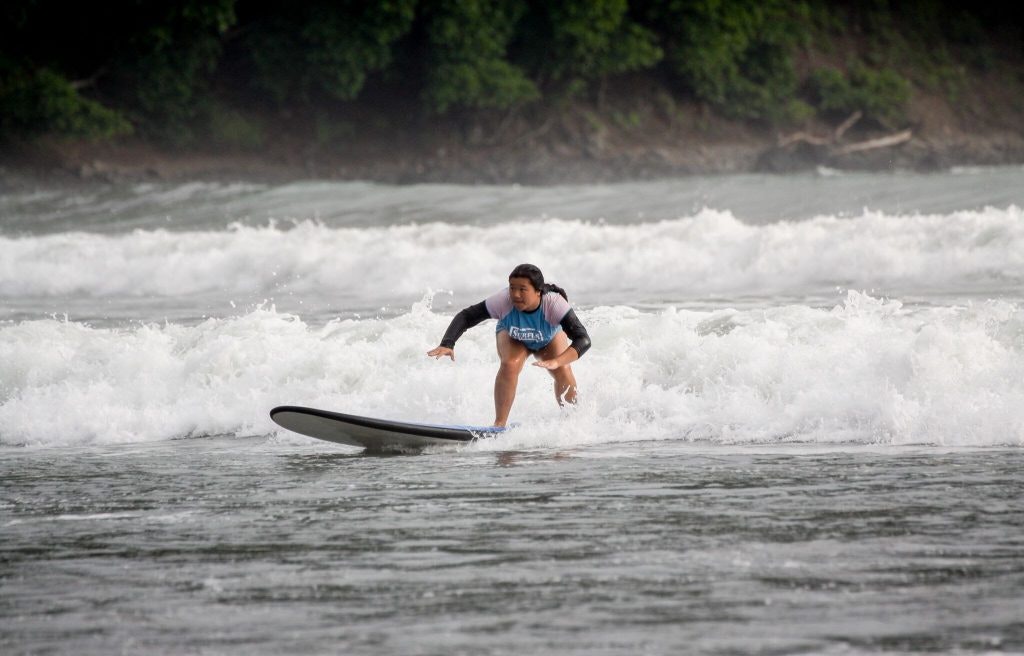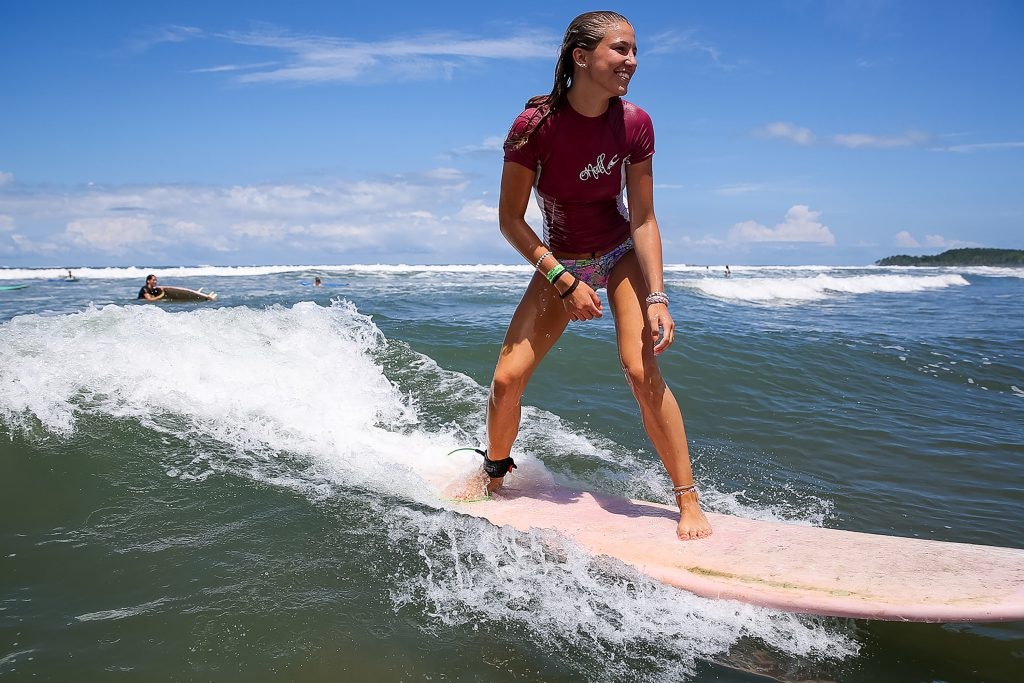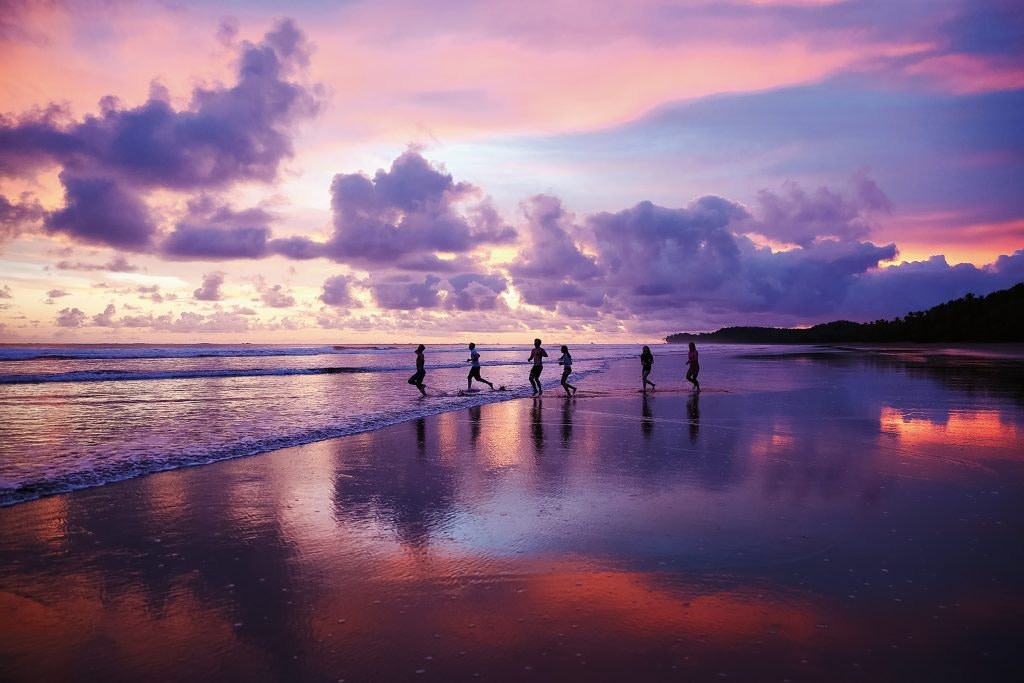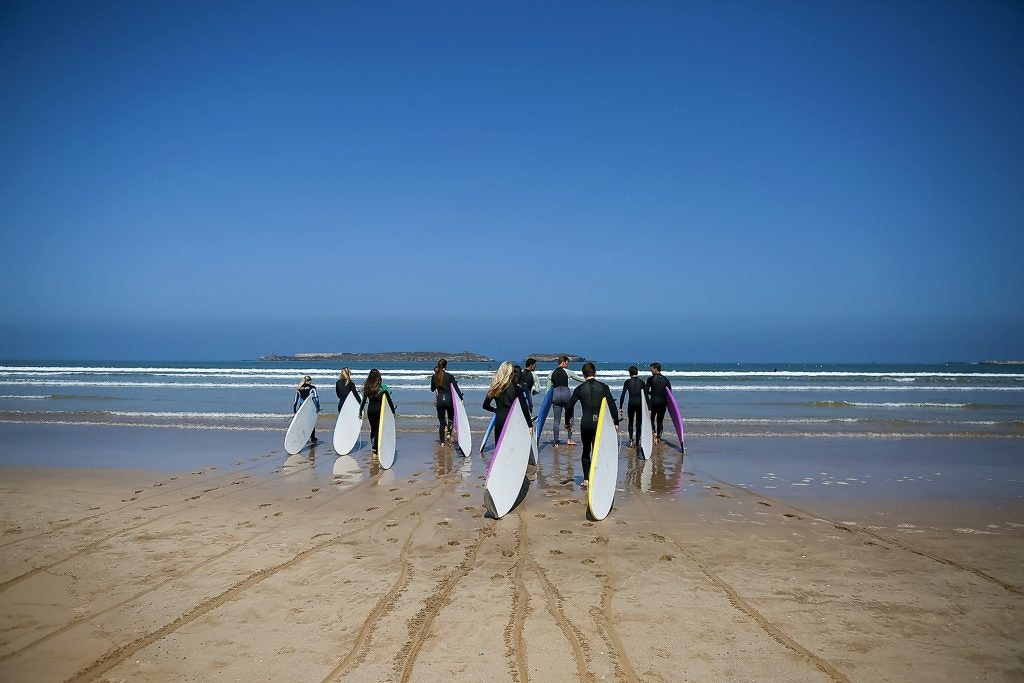







Having lived in a desert for the majority of my life, surfing was a sport I occasionally saw in movies about Cali surfer dudes and all of their “gnarly shredding”. It wasn’t until my mid-20s on a beach in Bali that I tried surfing for the first time. I learned two things:
1. Surfing is TIRING and HARD,
2. Surfing is FUN.
Like much of the world, I was convinced that surfing was a sport I should be paying more attention to and trying whenever I get the chance.
Modern surfing is considered to be one of the fastest-growing sports in the world. This popularity propelled the sport to its Olympic debut in July 2021 and its return in the 2024 Paris Summer Games. Surfing is now a permanent Olympic sport and will be a part of the Los Angeles 2028 Olympic Games.
Here are some interesting and fun facts about surfing to get you excited to watch the athletes this summer and maybe catch some big waves yourself on a teen travel program abroad with Rustic Pathways.
Archaeological evidence suggests surfing began in Peru. Over 4,000 years ago, ancient Peruvian fishermen used a woven reed watercraft to help them with their work. The earliest surfboards were very different from modern surfboards, though the concept remained the same. The fishermen would stand, kneel, or sit on the pointed-nose reed vessels to get back to shore after laying fishing nets.
Some uncovered Inca artwork from the time period features depictions of wave riding. These art forms provide valuable insights into the historical significance of surfing in Ancient Peru.
As Polynesian navigators crossed vast distances across the Pacific Ocean, they are believed to have arrived in Hawaii around 1,500 years ago, bringing with them ancient surfing practices. Over the years, Hawaiians developed specific types of surfboards like the Alaia (shorter, thinner boards) and Olo (longer, thicker boards), using native woods such as Acacia koa.
Up until the 1950s, solid wood surfboards were still being used. To improve their grip on these boards, surfers would coat their wooden boards with a thin layer of sand-infused varnish. Though the varnish increased traction, the sand also scraped their knees, chest, feet and thighs. In 1935, a teenager named Alfred Gallant Jr. applied a small amount of liquid floor wax to the deck of his surfboard. This marked the beginning of using surf wax on surfboards to enhance traction and do away with bloody knees and hands.
Today, modern surfboards are made out of materials like polyurethane, fiberglass and epoxy resin to provide surfers with lighter and more durable boards. Surf wax, primarily made from paraffin and beeswax, is still applied to these modern boards.
In the Aloha State, surfing has played a significant role in the local culture. Hundreds of years ago racing competitions on the water were common, and surfing was often associated with native religious practices. Surfboards were crafted during religious rituals, and the indigenous population would partake in sacred rituals designed to call forth large waves and honor their spiritual connections with the ocean. Colonialism threatened these native Hawaiian practices as missionaries aimed to stop pagan rituals and encourage modest dressing.

Rustic Pathways, Aloha Service, Summer 2019
2019 © Steve Boyle
Surfing was so ingrained in the culture that the sport survived and is a thriving industry in Hawaii. Several beaches in the state are considered among the most challenging surfing sites in the world. Surfers seek the supreme pleasure of catching waves in beaches like Pipeline and Waimea Bay in Oahu and Peahi or “Jaws” in Maui. Surfers also have a number of other options including Kailua-Kona on Big Island.
One of the best things about surfing is that it inspires people to travel. For surfers, learning to read different oceans and anticipate changes in wave conditions is crucial. Depending on factors such as ocean topography, high and low tide levels, wave height, wave type and wave formation, surf conditions can vary significantly.
Numerous destinations are featured on “best” surfing site lists in addition to the beaches in Hawaii. This includes Jeffreys Bay in South Africa for big wave surfers, Huntington Beach, in Southern California, United States, Bondi Beach in Sydney, Australia for cold water surfers and Taghazout in Morocco.

Beaches on the Nicoya Peninsula in Costa Rica are often featured on many best lists. In Costa Rica, these beaches boast warm waters and sandy bottom breaks, offering a surfing experience suitable for both beginners and experienced surfers.
For those interested in riding stationary waves, check out surf parks with a wave pool like Surf Snowdonia in Wales, United Kingdom and BSR Cable Park in Texas, U.S. Wave pools use technology to generate an artificial wave that remains in a fixed position for surfers. Natural stationary waves can also be found in certain rivers around the world like in Eisbach, Munich, Germany, and the Bono tidal bore in Indonesia. These river waves form when water flows over submerged obstructions, creating a standing wave.
In general, surfing gives you a great excuse to travel. There are so many waves to conquer and different scenery to enjoy. Plus, it’s an activity that can be enjoyed for many years. Professional surfers often compete for decades. 49-year-old professional surfer Kelly Slater even won a competition as recently as 2019.
Experienced surfers know that surfing is 80% paddling and 20% actually riding the wave. Unless you are surfing every day, many surfers may not be able to do what the pros do, but there are numerous fun skills to learn at different levels. Beginners should first learn to paddle quickly to gain enough momentum to catch a wave. Then, the challenge is to pop up on your surfboard without falling over.
The first time a surfer successfully pops up is definitely a ‘pat yourself on the back’ moment. Only a surfer knows the feeling of gliding on top of a wave with their board while defying gravity.

Credit: Rustic Pathways, Copyright: © 2015 Rustic Pathways
After learning the basics, surfers can try to perfect a duck dive or turtle roll to get under waves when waves break. As they improve, they can try out maneuvers such as strong turns and cutbacks, which involve turning the board back to the breaking wave. There are also 360s, tube rides and more – enough skills to keep you coming back for more surf time.
Beware of point breaks and reef breaks when tackling larger waves! Understanding wave height and types of wave breaks is essential for surfers seeking optimal conditions. A reef break at low tide occurs when waves break over coral reefs, often resulting in powerful, hollow waves. Point breaks occur where waves break along a point of land or rocks, producing longer waves.
Newbies may not realize how much etiquette is involved in surfing when they see a lineup of surfers in the water. The gist of the rules is simple – take your turn and don’t cut people off. The person at the highest point of a peak gets the wave and if you try to drop in front of them, you could cause an accident and gain the disapproval of fellow surfers.
Surfers also regularly chastise “snakes,” surfers who quickly maneuver around others to try to get to the peak when a wave rolls in. That’s where waiting your turn comes into play. There are many videos on etiquette to give new surfers a primer. By being polite and trying your best, it’s hard to go wrong.
Once you fall in love with surfing, it’s natural to be concerned about the environment. Surfers are generally in tune with nature since their craft depends on ocean waves and other healthy beach conditions. Water and beach pollution can wreak havoc, as can an imbalance of wildlife. When a pipeline installation, for example, causes an explosion of jellyfish, that could cause trouble.
Because of this connection with the water, surfers are known for their environmental stewardship. In some cases, they have successfully won legal battles against companies polluting the water and have halted development projects that would harm beaches. Environmental stewardship is also one of the cornerstones of International Surfing Day, held on June 20. Among other things, it recognizes the surfing community’s commitment to the ocean’s sustainability of resources.

Copyright: © 2016 Rustic Pathways
The surfing community is so strong that it has inspired trends ranging from music to popular slang words and fashion. To this day, “board shorts” are popular even among people who do not surf.
The growth of “surf tourism” has also expanded the ability of surfers to meet people from all different backgrounds when they take to the waters to catch waves.

Copyright: © 2015 Rustic Pathways
This is a key aspect of surfing that Australian surfer Stephanie Gilmore enjoys about the sport. As a seven-time world champion, she has traveled to some of the best beaches in the world, but it’s the people who always make the biggest impact.
“Surfing is not just a sport but a way to experience different cultures,” Gilmore said. “Experiencing different cultures is one of the best things a human being can do. It puts your whole world into perspective.”
Hear from Nora Shah, 17, a Rustic alumnus who participated in our surfing program in Costa Rica:
To try your hand at surfing and immerse yourself in Costa Rican culture, snag one of the remaining spots in Rustic’s Surf and Service program. More information about traveling to Costa Rica can be found here.
💡 Want more trivia?
Browse all Fun Facts articles.